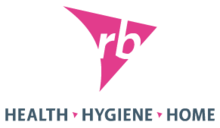Dettol
 | |
| Product type | Hygiene product |
|---|---|
| Owner | Reckitt Benckiser |
| Country | United Kingdom |
| Introduced | 1936 |
| Markets | Australia, Canada, India, Indonesia, Pakistan, South Africa, and the United Kingdom |
| Previous owners | SSL International |
| Website |
www www www www www www |
Dettol is the trade name for a line of hygiene products manufactured by Reckitt Benckiser. It has been in use since before 1936, when it was used after surgery as an antiseptic.[1]
Composition and chemistry
The original Dettol liquid antiseptic and disinfectant is light yellow in colour in the concentrated form but, as several of the ingredients are insoluble in water, it produces a milky emulsion of oil droplets when diluted with water, exhibiting the ouzo effect.
The active ingredient in Dettol that confers its antiseptic property is chloroxylenol (C8H9ClO), an aromatic chemical compound. Chloroxylenol comprises 4.8% of Dettol's total admixture,[2] with the rest made up by pine oil, isopropanol, castor oil, soap and water.
Usage
Diluted, Dettol may be used to clean cuts, wounds, etc. and to disinfect environmental surfaces such as household floors and kitchen work surfaces.
Toxicity
Humans
As with other manufactured household cleaners, Dettol has the potential for causing lethal toxicity. It is poisonous when ingested and even when it is unintentionally inhaled.
In a case report, a 42-year-old British man died from Dettol overexposure in May 2007. He was suffering from "obsessive cleaning disorder" and used to keep buckets of dettol around his flat with rooms littered with dettol. The autopsy was not able to conclude whether the lethal exposure to Dettol was via ingestion or inhalation.[3] A medical study which analyzed 177 cases of Dettol intoxications via ingestion in Hong Kong concluded that ″Dettol poisoning resulted in serious complications in 7% of patients, including death".[4]
Animals
Dettol is toxic to many animals, especially cats.[5] Dettol contains the phenol chloroxylenol. Phenols are of particular concern because cats are unable to eliminate the toxins following ingestion. A cat may swallow the product by licking its paws after they have come into contact with it.
In Australia, Dettol spray has been shown to be lethal to cane toads, an invasive species that was introduced from Hawaii as a result of bad judgment in 1935. It had been hoped that the amphibian would control the cane beetle but it became highly destructive within the ecosystem. Spraying the disinfectant at close range has been shown to cause rapid death to toads. It is not known whether the toxins are persistent or whether they harm other Australian flora and fauna.
Owing to concerns over potential harm to other Australian wildlife species, the use of Dettol as an agent for pest control was banned in Western Australia by the Department of Environment and Conservation in 2011.[6]
See also
References
- ↑ Rolleston, H. (1936). British Encyclopaedia of Medical Practice, Volume 1, Anus Diseases. London: Butterworth & Co. p. 671.
- ↑ "Summary of Product Characteristics / Dettol Liquid" (PDF). MHRA. 22 November 2010. Retrieved 9 November 2014.
- ↑ Lester Haines (29 May 2007). "'Dettol Man' cleans himself to death". The Register. Retrieved 2 February 2013.
- ↑ PK Lam; CK Chan; ML Tse; FL Lau (August 2012). "Dettol poisoning and the need for airway intervention" (PDF). Hong Kong Medical Journal. 18 (4): 270–275. PMID 22865169. Retrieved 29 March 2015.
- ↑ "Cats and poisons". icatcare.org.
- ↑ Narelle Towie (23 May 2009). "Cane toad poison banned". Perth Now. Retrieved 2 February 2013.
External links
- Dettol | Official website Australia
- Dettol | Official website India
- Dettol | Official website Pakistan
- Dettol | Official website South Africa
- Dettol | Official website UK
